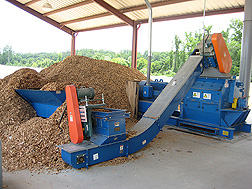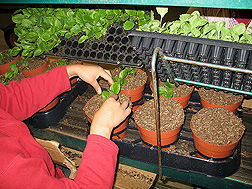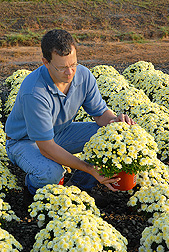Whole Tree: A More Sustainable,
Environmentally Friendly Substrate
|
|
At Young’s Plant Farm in Auburn, Alabama, rows of southern pine trees (Pinus taeda) stretch as far as the eye can see. But these trees won’t be used to decorate landscapes and parks or to provide shade on a hot day. Instead, these pine trees—commonly known as “loblolly pine”—will be used to grow the vibrant, healthy potted plants we see in nurseries and garden centers.
Nursery plants are grown in containers filled with a soil-less potting media, formally called “substrate,” which typically consists of Canadian peat moss, perlite (heat-expanded volcanic rock), vermiculite (heat-expanded silicate mineral), and pine bark. But the process of harvesting, preparing, and shipping peat moss, perlite, and vermiculite requires tremendous energy inputs. Also, the availability of pine bark has been tenuous because it depends on the stability of various other industries from which pine bark is derived.
Seeing this predicament, horticulturist Glenn Fain, formerly with the ARS Thad Cochran Southern Horticultural Laboratory in Poplarville, Mississippi, and Charles Gilliam, a professor at Auburn University, began looking for an alternative material to use as a substrate or substrate component. Fain continues to collaborate with Jim Spiers, research leader of the Poplarville laboratory; Anthony Witcher, a doctoral student and horticulturist at Poplarville; and Greg Young, owner of Young’s Plant Farm. In 2005 and 2006, ARS, Auburn University, and Young’s Plant Farm entered into specific cooperative agreements to develop a new substrate they call “WholeTree.”
|
|
Locally Produced, Completely Self-Sustainable
As its name suggests, WholeTree is made from all parts of the loblolly pine—bark, needles, wood, and cones. The word “loblolly” means “low, wet place,” but these trees aren’t limited to that environment. Loblolly pines grow well in acidic clay soil, which is commonly found in the South, and can be found in large groups in rural areas. But trees used to make WholeTree aren’t taken from natural areas; they’re farmed at tree plantations across the southeastern United States.
The pine trees used are those that are harvested from pine plantations at the thinning stage. “Thinning” is when some trees are removed to achieve a density the site can support. The trees are then chipped and further processed to achieve the desired physical properties needed for a substrate component. Similar products have been available in Europe for several years, but WholeTree could be one of the first available products for the United States made from locally grown materials.
“We’ve taken a locally available product that’s native to this region and that’s already being farmed, and we’ve used it to make a more environmentally friendly product,” says Fain, now an assistant professor at Auburn University. “It’s completely self-sustainable and would cost less than other substrates on the market.”
|
|
Field and laboratory studies have demonstrated the successful use of WholeTree, even at 100 percent for some nursery plants. In one study, Fain and colleagues compared chrysanthemums grown in WholeTree with those grown in a WholeTree-and-peat moss mix and a peat moss-and-perlite mix. The scientists collected data on plant growth, flower bud number, leaf chlorophyll content, root rating, shoot dry weight, and nutrient content of plant tissue. In the end, they found minimal differences between the plants, all of which were considered marketable at the conclusion of the study. Other studies have produced similar results with only minor changes in cultural practices.
Results from the studies have been so promising that in 2008, Young’s Plant Farm, a supplier to retail outlets such as Lowe’s and Wal-Mart, made a significant investment in order to adopt this technology and further the research on a larger scale. They are now producing their own substrate component, farming and harvesting pine trees produced at one of their farms to make WholeTree. In fact, Wal-Mart recently recognized Young’s Plant Farm for their efforts with a supplier sustainability award for using the product.
“Other plant suppliers can adopt this technology, although some cultural practices will have to be altered,” says Fain. “WholeTree has the potential to be an economically sustainable substrate component that could be available in close proximity to major horticultural production areas throughout the Southeast.”
Further Testing and Future Applications
Witcher, Fain, Spiers, and Eugene Blythe, an assistant research professor at Mississippi State University’s South Mississippi Branch Experiment Station in Poplarville, are currently conducting further studies evaluating WholeTree’s use in cutting and seedling propagation of herbaceous perennial and woody ornamental crops. So far, they have conducted tests on plants popular to the ornamental and landscaping industries, such as the garden mum, perennial salvia, climbing rose, and Leyland cypress.
“We’ve had promising results, but we need to further examine the physical properties of WholeTree,” says Witcher. “We want to create an optimal mix of air space and water-holding capacity in the substrate to enhance root development in these plants. We also want to create a particle size that works well for a wide range of crops.”
Researchers are planning to conduct trials using WholeTree as a landscape soil amendment. According to Fain, it is typical practice to add an organic amendment to the soil, especially in heavy clay soils. In the southeast, aged pine bark and peat moss are standard soil amendments. WholeTree will be compared with these standards to determine its potential use in the landscape industry.
Scientists are also planning to conduct plant-growth-response trials at other producer locations in the southeast. And they are looking into the possibility of using other species of trees growing in southern forests as standalone substrates or substrate components.
If all goes well, you may soon see plants grown in WholeTree in a nursery near you.—By Stephanie Yao, Agricultural Research Service Information Staff.
This research is part of Crop Production, an ARS national program (#305) described at www.nps.ars.usda.gov.
To reach scientists mentioned in this article, contact Stephanie Yao, USDA-ARS Information Staff, 5601 Sunnyside Ave., Beltsville, MD 20705-5129; (301) 504-1619.
"Whole Tree: A More Sustainable, Environmentally Friendly Substrate" was published in the August 2010 issue of Agricultural Research magazine.









